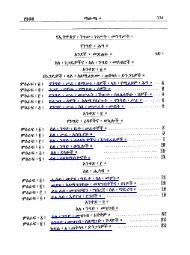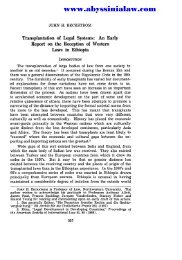Create successful ePaper yourself
Turn your PDF publications into a flip-book with our unique Google optimized e-Paper software.
IOWA LAW REVIEW<br />
enforcement in the courts is only one. 2 71 At least theoretically, then,<br />
litigation takes on a greater role in the common-law system, and detailed<br />
rules have been developed to govern the conduct of litigation.<br />
A nation developing its procedural system will essentially follow<br />
one or the other approach to litigation. Ethiopia has opted for the<br />
common-law approach. Under the Criminal Procedure Code, the<br />
prosecution is adversary rather than inquisitorial, and the traditional<br />
guarantees of the criminal accused which form an integral part of common-law<br />
criminal procedure exist in Ethiopia. 2 7 2 The Civil Procedure<br />
Code contains the features of common-law procedure with which we<br />
are familiar: pleading, 27 3 stage preclusion, a separate trial as opposed<br />
to conferences and proof-taking, direct and cross-examination, and<br />
specific powers and limitations for the judge. The adversary system of<br />
litigation with party responsibility for presentation of the case is also<br />
employed. Consideration may now be given the reasons why Ethiopia<br />
adopted the common-law approach toward procedure despite the fact<br />
the substantive law was based on continental models.<br />
There appear to be four factors which led to the adoption of this<br />
approach: (1) the traditional method of litigation was adversary and<br />
depended on party presentation; (2) following the Liberation, a<br />
number of British judges were appointed to the High Court who influenced<br />
the attitudes of Ethiopian judges toward procedure; (3)<br />
litigation had always been considered extremely important and would<br />
continue to be so, which necessitated procedural rules that would<br />
expedite the conduct of such litigation; and (4) the judiciary did not<br />
enjoy such confidence that they could be trusted with wide discretion.<br />
First, litigation, as has been pointed out repeatedly, was long a<br />
prominent feature of the Ethiopian scene. This litigation was an<br />
individual matter; one person accused another before the judge. As<br />
such, he presented his own case, and the judge was in the position of<br />
arbiter..<br />
2 74 [Vol. 53<br />
www.abyssinialaw.com<br />
The proceedings were completely adversary in nature. In<br />
criminal cases also, the concept of private prosecution was well-<br />
2 7 establishedY. Thus, these proceedings were adversary rather than<br />
inquisitorial.<br />
Second, when the British judges presented the idea of the adversary<br />
2 7 1 R. DAVID & H. DE VRIES, TnE FRENcH LEGAL SYSTEM 79 (1958).<br />
272 Such guarantees are also contained in the Constitution. See ETIOPLo REvism<br />
CoNST. arts. 51-57.<br />
272 For a discussion of the distinction between the place of pleading in the<br />
common-law and civil-law systems, see C. CLAPx, CODE PLEADING 9-12 (2d ed.<br />
1947). Pleading is virtually of no importance in the civilian system, and the issues<br />
are developed by the court during the conferences.<br />
274See Graven, La Nouvelle procedure penle ethiopienne, 79 REvuE P ALE<br />
SuIssE 70, 75-76 (S. Mikael transl. 1963).<br />
275 Id. at 71-72.





